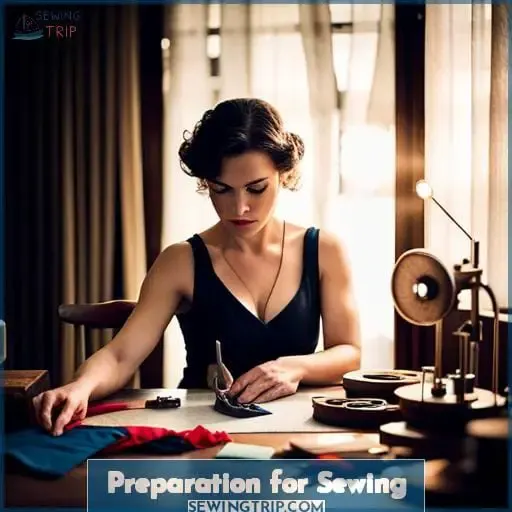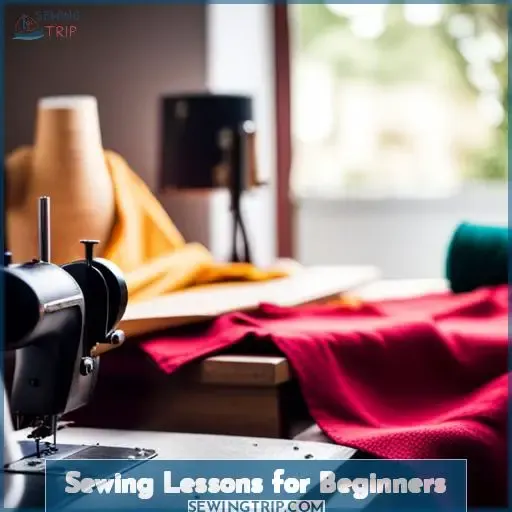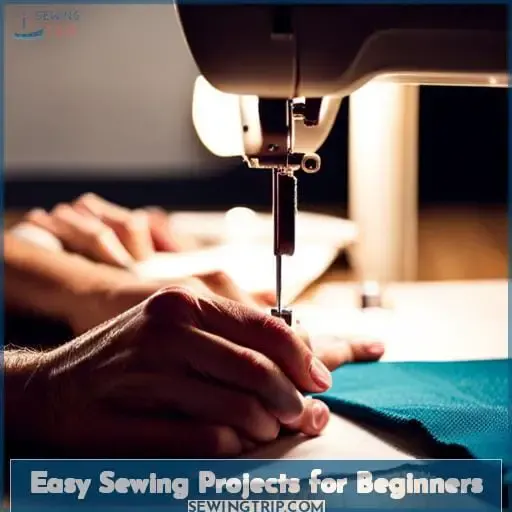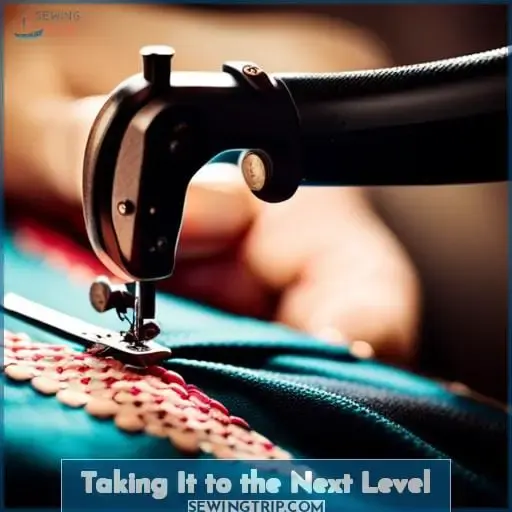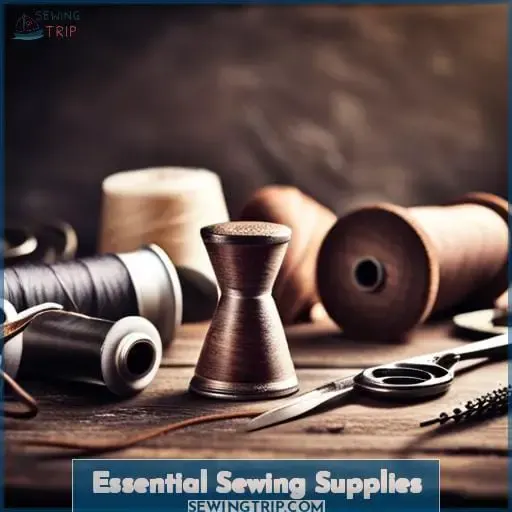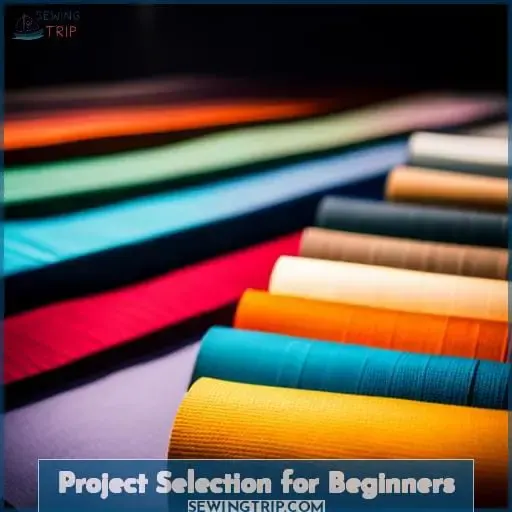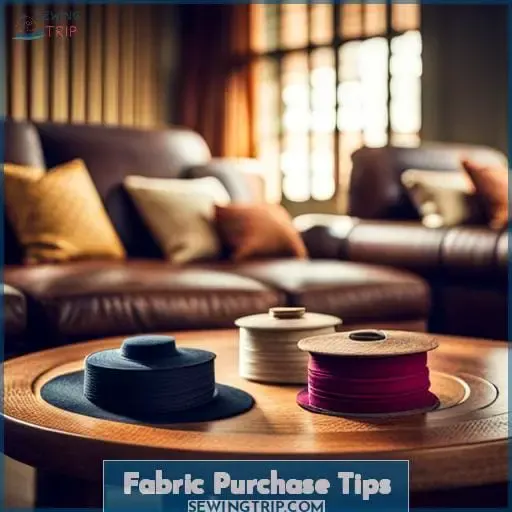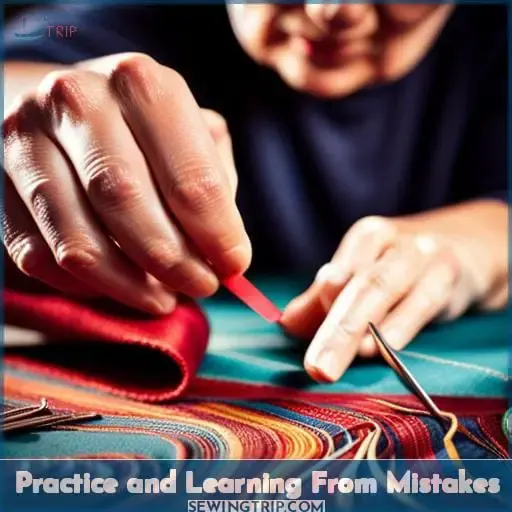This site is supported by our readers. We may earn a commission, at no cost to you, if you purchase through links.
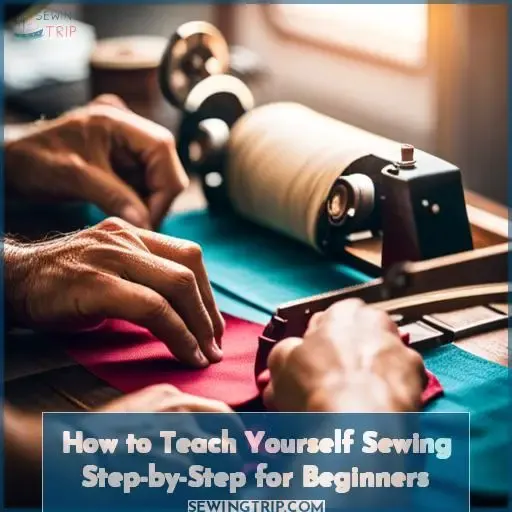 Grab your machine, and let’s start sewing!
Grab your machine, and let’s start sewing!
We’ll cover everything from threading your bobbin to finishing easy projects. Don’t be intimidated.
I’ll walk you through sewing basics, from how to use a machine to essential tools. Together, we’ll select beginner patterns featuring straight lines that build confidence.
Mistakes happen; be patient and keep trying. You’ve got this – let’s get stitching!
Table Of Contents
Key Takeaways
- Focus on starting simple by practicing with scraps and inexpensive fabrics to build skills and confidence
- Utilize resources like online tutorials, books, blogs and online groups for sewing lessons, pattern help, inspiration and troubleshooting
- Invest time practicing basic techniques like stitching straight lines and working with different fabrics to gain experience
- View mistakes as learning opportunities, reflect on what went wrong and make adjustments to improve
Sewing Machine Basics
When choosing your first sewing machine, consider your budget, the features you need, and how user-friendly the machine is for a beginner.
Avoid getting overwhelmed by all the options and focus on finding a quality starter machine with key features to learn on.
Look for easy threading, adjustable stitch length and width, a top loading bobbin, and automatic needle threader.
These user-friendly functions will make learning much smoother.
Set aside time to fully read the manual and watch any video tutorials so you understand how to thread, wind a bobbin, change stitches, and operate your machine.
Be patient with yourself as you practice sewing straight lines and curves.
It may take some time to get the hang of controlling speed and coordinating your hands.
The more you use your machine, the more comfortable you’ll become.
With persistence, you’ll gain confidence threading, adjusting settings, and completing basic techniques.
Preparation for Sewing
Before sewing, gather basic supplies:
- Fabric
- Thread
- Seam ripper
- Pins
- Scissors
- Bobbins
Having the right tools available before you start a project allows for an easier learning experience.
- Fabric
- Multiple colors of all-purpose thread
- Seam ripper
- Pins
- Fabric scissors
- Hand-sewing needles
- Extra bobbins
Beyond the essentials, consider a tailor’s chalk, transparent ruler, and pincushion to make sewing prep easier.
Next, find a dedicated workspace with good lighting and ample flat surface area to layout your supplies. Keep your sewing dictionary close by for referencing terms and techniques. Take time beforehand to understand the types of fabric you’ll be sewing with through burn tests and stretch tests.
Threading practice on scraps also helps build confidence before tackling projects.
Sewing Lessons for Beginners
Now that you’ve prepared your sewing area and gathered the necessary supplies, it’s time to dive into sewing lessons for beginners.
There are various options available to teach yourself sewing:
- Online Classes: Take advantage of online classes that offer comprehensive instruction and guidance from experienced sewers.
- Video Tutorials: YouTube is a treasure trove of video tutorials on everything from basic stitches to advanced techniques.
- Pattern Troubleshooting: Learn how to troubleshoot common issues with sewing patterns through blog posts and forums dedicated to helping beginners.
- Book Learning: Expand your knowledge with books specifically designed for beginner sewers, offering step-by-step instructions and helpful illustrations.
- DIY Approach: Embrace the freedom of teaching yourself by experimenting with different projects using online resources like blogs or Pinterest for inspiration.
Whether you choose one method or combine multiple approaches, remember that practice makes perfect in the world of sewing!
Easy Sewing Projects for Beginners
As your skills improve, look for projects with straight lines and minimal embellishments to help build your confidence.
Blankets, pillows, burp cloths, and key fobs utilize straight seams while allowing creativity in fabric choice.
For household use, consider pillowcases, pot holders, placemats, or a basic tote bag.
| Project | Skill Level | Key Learnings |
|---|---|---|
| Pillows | Beginner | Practice straight lines and corners |
| Blankets | Beginner | Learn to sew large pieces of fabric together |
| Key Fobs | Beginner | Apply fasteners like grommets or buttonholes |
| Pot Holders | Beginner + | Add batting and make rounded corners |
| Tote Bags | Intermediate | Sew curves, box corners, and add straps |
As you start, use muslin or scrap fabric to allow mistakes. Check pattern reviews online for guidance.
Stay motivated by starting simply and building competency with each new project. With practice, precision, and persistence, you’ll be creating amazing handmade items in no time!
Taking It to the Next Level
Once you have gained confidence in your basic sewing skills, you’ll want to explore more advanced techniques like garment construction or quilting.
As you continue practicing and refining your skills, refer to online resources and eBooks for a wide range of project ideas to help you become a proficient sewer.
Advance your skill enhancement journey by taking a deep dive into sewing tips and tutorials focused on specific techniques like draping, tailoring, pattern making, embroidery, appliqué, and other unique skills.
Use your newfound knowledge to start having fun constructing unique garments, accessories like handbags or wallets, home décor items like quilts or cushion covers, or toys.
Let your imagination run wild with advanced sewing exploration – the possibilities are endless once you’ve mastered the fundamentals.
Essential Sewing Supplies
Before purchasing supplies, recognize that sewing requires an initial investment in tools.
Borrow or find a sewing machine from friends or family to avoid the initial cost.
Purge your closets for fabric you can reuse for projects. Old bedsheets or curtains work well.
Shop the remnant bin at your local fabric store for budget-friendly options. Get creative with pattern choices to maximize what you can make.
Friends and family may donate fabric once they know you’re getting into sewing. Check thrift stores as another source for cheap fabric finds.
With some effort, you can build up a stash of sewing fabric without breaking the bank.
Rely on websites, YouTube, books from the library, or DVDs to educate yourself for free.
Approach this new hobby open-minded, and you’ll be sewing fabulous creations in no time.
Project Selection for Beginners
When starting out, choose patterns labeled easy or beginner.
Go for projects with straight lines and few pattern pieces to master skills.
Using an inexpensive muslin fabric allows you to make mistakes without breaking the bank.
Choose Easy Patterns
When picking your first sewing project:
- Choose an easy pattern with minimal details like ruffles or darts.
- Opt for designs labeled beginner or easy with straight lines and few pattern pieces.
Consider projects like:
- Pillows
- Tote bags
- Skirt panels
- Key fobs
- Other simple items
These help build skills without too much frustration for a novice sewer.
Use Muslin Fabric
You should purchase muslin fabric if you don’t have scrap fabric handy for your first project.
Muslin is inexpensive, allows mistakes, and lets you perfect the pattern before using your desired nice fabric.
The 3 key benefits are:
- Affordable to practice on.
- Forgiving of beginner mistakes.
- Allows getting pattern right before using good fabric.
Prioritize Straight Lines
Select projects featuring primarily straight lines while learning to sew.
Prioritize patterns with minimal curved seams, darts, gathers, or pleats.
Start with table runners, pillowcases, blankets, burp cloths, or aprons to practice straight line techniques for seam perfection.
As you master precision stitching and straight stitch mastery builds linear sewing skills, gradually incorporate slightly more complex designs.
Fabric Purchase Tips
Considering your budget, purchase muslin fabric for your first project and then use your desired, quality fabric once you have the sewing basics down.
Seek out inexpensive cotton fabrics like muslin, broadcloth, or quilting cottons for starter projects.
Scout discount or remnant bins at fabric stores for cheaper fabrics to practice on. Stay away from slippery silks or tricky knits until you have some sewing confidence.
Buy small cuts of different fabric types to experiment with how they feed through the machine and how needles, tension, and stitch settings may need adjusting.
Don’t select expensive, special occasion fabrics for early learning. Making mistakes on those could lead to Avoiding Fabric Fiascos down the road.
When tackling a bigger project, buy extra yardage, especially for patterned fabric.
Practice and Learning From Mistakes
Making mistakes while learning to sew is inevitable. Approach your practice time as an opportunity to educate yourself and improve.
Expect a learning curve as you familiarize yourself with your sewing machine and various techniques. When mistakes happen, reflect on what went wrong and how it can be avoided next time.
Consult troubleshooting tips in books or online to identify issues. Don’t be afraid to experiment with different settings and methods to find what works best for you.
Skill refinement comes through persistence despite mistakes. Maintain realistic expectations of yourself as a beginner and focus on gradual progress.
With each completed project, celebrate small wins while targeting areas needing more practice.
Sewing offers much reward for effort and patience with the learning process.
Frequently Asked Questions (FAQs)
What are some good online communities for connecting with other beginner sewers?
Stay focused on the joy of learning.
Connect with supportive communities to build skills, find inspiration, and share knowledge.
With patience and persistence, you’ll gain confidence stitch by stitch.
My machine is skipping stitches – what should I check first to troubleshoot this?
- Check that your machine is properly threaded.
- Ensure the tension is balanced.
- Examine and potentially replace the needle.
- Clean lint from the bobbin area.
- Use quality thread and stabilizer as needed.
I want to learn how to sew my own clothes. What projects help build skills for making garments?
Start with simple pieces like pillowcases, tote bags, and PJ pants to learn construction basics.
Then try skirts, dresses, and tops to practice darts, zippers, and sleeves.
Before tackling more complex garments, focus on fit, finishing, and quality as you go.
How do I know what size needle to use for different fabrics?
When selecting a needle, match it to your thread and fabric weight.
Finer threads and fabrics call for finer needles to avoid damage.
Heavier fabrics need thicker needles that won’t flex.
Consulting your machine’s manual is wise.
Simply put: let your materials guide your tool selection.
Are there any apps or software programs that can help with pattern drafting and design?
Yes, there are helpful apps for pattern drafting.
Try Pattern Marker or Seamly2D to digitize patterns.
Use your device’s stylus to draft designs, adjust measurements, and manipulate pattern pieces.
The real-time visual interface streamlines drafting and alterations.
With practice, these programs enable precise customization without paper and pencils.
Conclusion
As you snip the final threads, admire your finished project.
Those first wobbly seams are now badges of honor.
Like any skill, mastery comes through practice.
Don’t stash your machine just yet.
How to teach yourself sewing is an ongoing lesson.
Let your creative spirit soar by applying these fundamentals to invent new designs.
With patience and persistence, you’ll stitch up success.

